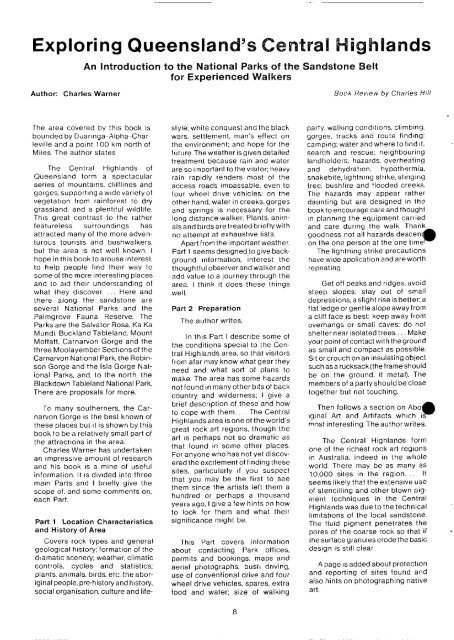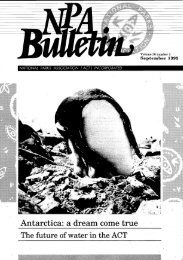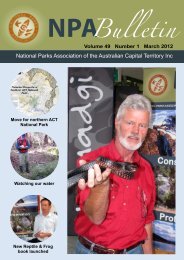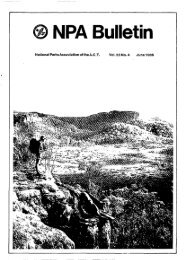Vol 25 No 3 Mar 1988 - National Parks Association of the ACT
Vol 25 No 3 Mar 1988 - National Parks Association of the ACT
Vol 25 No 3 Mar 1988 - National Parks Association of the ACT
You also want an ePaper? Increase the reach of your titles
YUMPU automatically turns print PDFs into web optimized ePapers that Google loves.
Exploring Queensland's Central Highlands<br />
An Introduction to <strong>the</strong> <strong>National</strong> <strong>Parks</strong> <strong>of</strong> <strong>the</strong> Sandstone Belt<br />
for Experienced Walkers<br />
Author: Charles Warner Book Review by Charles Hill<br />
The area covered by this book is<br />
bounded by Duaringa-Alpha-Charleville<br />
and a point 100 km north <strong>of</strong><br />
Mites The author states<br />
The Central Highlands <strong>of</strong><br />
Queensland form a spectacular<br />
series <strong>of</strong> mountains, clifflines and<br />
gorges, supporting a wide variety <strong>of</strong><br />
vegetation from rainforest to dry<br />
grassland, and a plentiful wildlife.<br />
This great contrast to <strong>the</strong> ra<strong>the</strong>r<br />
featureless surroundings has<br />
attracted many <strong>of</strong> <strong>the</strong> more adventurous<br />
tourists and bushwalkers,<br />
but <strong>the</strong> area is not well known. I<br />
hope in this book to arouse interest,<br />
to help people find <strong>the</strong>ir way to<br />
some <strong>of</strong> <strong>the</strong> more interesting places<br />
and to aid <strong>the</strong>ir understanding <strong>of</strong><br />
what <strong>the</strong>y discover. ... Here and<br />
<strong>the</strong>re along <strong>the</strong> sandstone are<br />
several <strong>National</strong> <strong>Parks</strong> and <strong>the</strong><br />
Palmgrove Fauna Reserve. The<br />
<strong>Parks</strong> are <strong>the</strong> Salvator Rosa. Ka Ka<br />
Mundi, Buckland Tableland, Mount<br />
M<strong>of</strong>fatt. Carnarvon Gorge and <strong>the</strong><br />
three Moolayember Sections <strong>of</strong> <strong>the</strong><br />
Carnarvon <strong>National</strong> Park, <strong>the</strong> Robinson<br />
Gorge and <strong>the</strong> Isla Gorge <strong>National</strong><br />
<strong>Parks</strong>, and, to <strong>the</strong> north, <strong>the</strong><br />
Blackdown Tableland <strong>National</strong> Park.<br />
There are proposals for more.<br />
To many sou<strong>the</strong>rners, <strong>the</strong> Carnarvon<br />
Gorge is <strong>the</strong> best known <strong>of</strong><br />
<strong>the</strong>se places but it is shown by this<br />
book to be a relatively small part <strong>of</strong><br />
<strong>the</strong> attractions in <strong>the</strong> area.<br />
Charles Warner has undertaken<br />
an impressive amount <strong>of</strong> research<br />
and his book is a mine <strong>of</strong> useful<br />
information. It is divided into three<br />
main Parts and I briefly give <strong>the</strong><br />
scope <strong>of</strong>. and some comments on,<br />
each Part.<br />
Part 1 Location Characteristics<br />
and History <strong>of</strong> Area<br />
Covers rock types and general<br />
geological history; formation <strong>of</strong> <strong>the</strong><br />
diamatic scenery; wea<strong>the</strong>r, climatic<br />
controls, cycles and statistics;<br />
plants, animals, birds, etc; <strong>the</strong>aboriginal<br />
people, pre-history and history,<br />
social organisation, culture and lifestyle;<br />
white conquest and <strong>the</strong> black<br />
wars, settlement, man's effect on<br />
<strong>the</strong> environment; and hope for <strong>the</strong><br />
future. The wea<strong>the</strong>r is given detailed<br />
treatment because rain and water<br />
are so important to <strong>the</strong> visitor; heavy<br />
rain rapidly renders most <strong>of</strong> <strong>the</strong><br />
access roads impassable, even to<br />
four wheel drive vehicles: on <strong>the</strong><br />
o<strong>the</strong>r hand, water in creeks, gorges<br />
and springs is necessary for <strong>the</strong><br />
long distance walker. Plants, animals<br />
and birds are treated briefly with<br />
no attempt at exhaustive lists.<br />
Apart from <strong>the</strong> important wea<strong>the</strong>r,<br />
Parti seems designed to give background<br />
information, interest <strong>the</strong><br />
thoughtful observer and walker and<br />
add value to a journey through <strong>the</strong><br />
area. I think it does <strong>the</strong>se things<br />
well.<br />
Part 2<br />
Preparation<br />
The author writes.<br />
In this Part I describe some <strong>of</strong><br />
<strong>the</strong> conditions special to <strong>the</strong> Central<br />
Highlands area, so that visitors<br />
from afar may know what gear <strong>the</strong>y<br />
need and what sort <strong>of</strong> plans to<br />
make. The area has some hazards<br />
not found in many o<strong>the</strong>r bits <strong>of</strong> back<br />
country and wilderness; I give a<br />
brief description <strong>of</strong> <strong>the</strong>se and how<br />
to cope with <strong>the</strong>m. ... The Central<br />
Highlands area is one <strong>of</strong> <strong>the</strong> world's<br />
great rock art regions, though <strong>the</strong><br />
art is perhaps not so dramatic as<br />
that found in some o<strong>the</strong>r places.<br />
For anyone who has not yet discovered<br />
<strong>the</strong> excitement <strong>of</strong> finding <strong>the</strong>se<br />
sites, particularly if you suspect<br />
that you may be <strong>the</strong> first to see<br />
<strong>the</strong>m since <strong>the</strong> artists left <strong>the</strong>m a<br />
hundred or perhaps a thousand<br />
years ago, I give a few hints on how<br />
to look for <strong>the</strong>m and what <strong>the</strong>ir<br />
significance might be.<br />
This Part covers information<br />
about contacting Park <strong>of</strong>fices,<br />
permits and bookings; maps and<br />
aerial photographs; bush driving,<br />
use <strong>of</strong> conventional drive and four<br />
wheel drive vehicles, spares, extra<br />
food and water; size <strong>of</strong> walking<br />
party, walking conditions, climbing,<br />
gorges, tracks and route finding:<br />
camping; water and where to find it,<br />
search and rescue: neighbouring<br />
landholders; hazards, overheating<br />
and dehydration, hypo<strong>the</strong>rmia,<br />
snakebite, lightning strike, stinging<br />
tree, bushfire and flooded creeks.<br />
The hazards may appear ra<strong>the</strong>r<br />
daunting but are designed in <strong>the</strong><br />
book to encourage care and thought<br />
in planning <strong>the</strong> equipment carried<br />
and care during <strong>the</strong> walk. Thank<br />
goodness not all hazards descentJ<br />
on <strong>the</strong> one person at <strong>the</strong> one time<br />
The lightning strike precautions<br />
have wide application and are worth<br />
repeating<br />
Get <strong>of</strong>f peaks and ridges, avoid<br />
steep slopes; stay out <strong>of</strong> small<br />
depressions, a slight rise is better; a<br />
flat ledge or gentle slope away from<br />
a cliff face is best: keep away from<br />
overhangs or small caves; do not<br />
shelter near isolated trees Make<br />
your point <strong>of</strong> contact with <strong>the</strong> ground<br />
as small and compact as possible.<br />
Sit or crouch on an insulating object<br />
such as a rucksack (<strong>the</strong> frame should<br />
be on <strong>the</strong> ground, if metal). The<br />
members <strong>of</strong> a party should be close<br />
toge<strong>the</strong>r but not touching.<br />
Then follows a section on Abo^<br />
iginal Art and Artifacts which i<br />
most interesting. The author writes.<br />
The Central Highlands form<br />
one <strong>of</strong> <strong>the</strong> richest rock art regions<br />
in Australia, indeed in <strong>the</strong> whole<br />
world. There may be as many as<br />
10,000 sites in <strong>the</strong> region. .. It<br />
seems likely that <strong>the</strong> extensive use<br />
<strong>of</strong> stencilling and o<strong>the</strong>r blown pigment<br />
techniques in <strong>the</strong> Central<br />
Highlands was due to <strong>the</strong> technical<br />
limitations <strong>of</strong> <strong>the</strong> local sandstone.<br />
The fluid pigment penetrates <strong>the</strong><br />
pores <strong>of</strong> <strong>the</strong> coarse rock so that if<br />
<strong>the</strong> surface granules erode <strong>the</strong> basic<br />
design is still clear.<br />
A page is added about protection<br />
and reporting <strong>of</strong> sites found and<br />
also hints on photographing native<br />
art.








